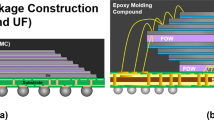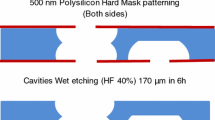Abstract
Packaging is one of the most critical tasks for MEMS devices. Unlike solid state devices, MEMS structures involves moving structures which needs to be protected from outer environment ensuring free movement of the structure. In the present paper, inverted silicon cavity is used for capping the MEMS devices. However, in case of RF MEMS, silicon cavity would add parasitics and affects its electrical performance. Enclosing the MEMS structure, its mechanical response will also alter. The electrical as well as mechanical characteristics of the RF MEMS switch are analyzed using finite element method simulations. The electrical response of the fabricated switch after packaging is compared with unpackaged device.










Similar content being viewed by others
References
Bansal D, Sharma A, Kaur M, Rangra KJ (2012) Design of vertical packaging technology for RF MEMS switch. In: 16th international workshop on physics of semiconductor devices, vol 8549, p 854–911
Bansal D, Kumar A, Sharma A, Rangra KJ (2015a) Design of compact and wide bandwidth SPDT with anti-stiction torsional RF MEMS series capacitive switch. Microsyst Technol 21(5):1047–1052
Bansal D, Bajpai A, Kumar P, Kumar A, Kaur M, Rangra K (2015b) Design and fabrication of a reduced stiction radio frequency MEMS switch. J Micro Nanolithogr MEMS MOEMS 14(3):35002
Bansal D, Bajpai A, Kumar P, Kaur M, Rangra K (2016) “Fabrication and analysis of radiofrequency MEMS series capacitive single-pole double-throw switch. J Micro Nanolithogr MEMS MOEMS 15(4):45001
Bansal D, Bajpai A, Kumar P, Kaur M, Kumar A, Chandran A, Rangra K (2017) Low voltage driven RF MEMS capacitive switch using reinforcement for reduced buckling. J Micromech Microeng 27(2):24001
Chiao M, Lin L (2006) Device-level hermetic packaging of microresonators by RTP aluminum-to-nitride bonding. J. Microelectromech Syst 15(3):515–522
Fang W, Wickert JA (1996) Determining mean and gradient residual stresses in thin films using micromachined cantilevers. J Micromech Microeng 6:301–309
Hennessy RP, Basu A, Adams GG, McGruer NE (2013) Hot-switched lifetime and damage characteristics of MEMS switch contacts. J Micromech Microeng 23(5):55003
Kim Y, Kim E, Kim S, Ju B (2008) Low temperature epoxy bonding for wafer level MEMS packaging. Sens Actuators A Phys 143(2):323–328
McGruer NE, Adams GG, Chen L, Guo ZJ, Du Y (2006) mechanical, thermal, and material influences on Ohmic-contact-type MEMS switch operation. In: 19th IEEE international conference on micro electro mechanical systems, January, pp 230–233
Melle S, Bordas C, Dubuc D, Grenier K, Vendier O, Muraro JL, Cazaux JL, Plana R (2007) Investigation of stiction effect in electrostatic actuated RF MEMS devices. In: 2007 topical meeting on silicon monolithic integrated circuits in RF systems, vol 21, no 2, pp 173–176
Morton MA, Papapolymerou J (2004) Wide-band finite ground coplanar (FGC) interconnects for on-chip packaging of RF MEMS switches used in smart antennas and phased arrays. IEEE Antennas Wirel Propag Lett 3(1):239–242
Rebeiz GM (2003) RF MEMS theory, design, and technology. Wiley, New Jersey
Acknowledgements
Author would like to thank Council of Scientific and Industrial Research (CSIR), India for providing financial assistance throughout the project MLP-105 and providing CSIR-SRF Fellowship.
Author information
Authors and Affiliations
Corresponding author
Additional information
Publisher's Note
Springer Nature remains neutral with regard to jurisdictional claims in published maps and institutional affiliations.
Author is very thankful for the Council of Scientific and Industrial Research (CSIR), India for providing funds through MLP-105 and CSIR-SRF Fellowship.
Rights and permissions
About this article
Cite this article
Anuroop, Bansal, D., Kumar, P. et al. Low temperature epoxy bonding for RF MEMS capacitive switch. Microsyst Technol 25, 3047–3051 (2019). https://doi.org/10.1007/s00542-018-4186-6
Received:
Accepted:
Published:
Issue Date:
DOI: https://doi.org/10.1007/s00542-018-4186-6




